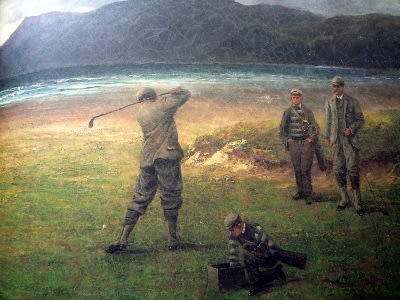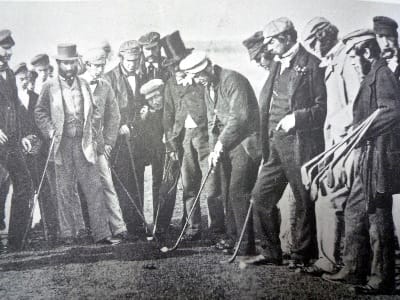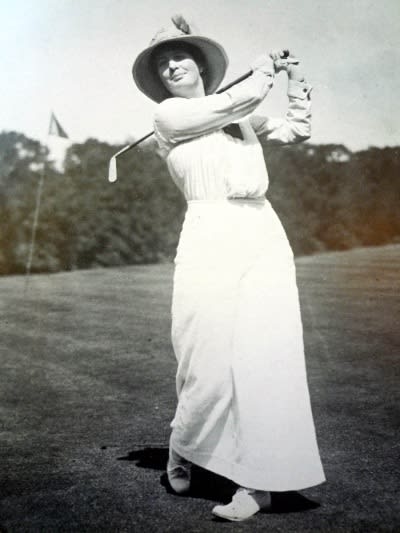ゴルフはいつ始まったのでしょうか。 その説は諸々のようです。世界各地に現代のゴルフの原型のようなスポーツが存在いたしました。Paganica(古代ローマのパガニカ)→Cambuca(14 世紀イングランド)、Pall mall/jeu de mail/pele mele(イタリア、フランス、イングランドのペルメル球戯)
、Chole(フランダース地方)、Soule(フランス北部)、Kolf/Het Kolven(オランダのコルフ)、Goff(15世紀スコットランド)などあげられます。

スコットランドにおいて、ゴルフは元々お金持ちのスポーツではありませんでした。ゴルフはスコットランド東海岸の、Links リンクス、と呼ばれる土地で、漁民たちの遊びでした。リンクスは海岸の砂地に芝が生えていて、土地はやせているので芝は密生せず丈は短く、当時は羊の放牧
地としてしか使えませんでした。羊が草を食べると、芝は短くなり、砂地は水はけもよく、海岸に近いリンクスは冬でも雪はあまり降り積もらないのも、ゴルフ には好都合でした。また、緯度の高いスコットランドは、特に夏が長いので十分楽しむことができたのもよかったのでしょう。

ところで、当時、私たちのようなウィークエンドゴルファーはいませんでした。人々は週6日働き、日曜日は安息日でスポーツに親しむのも禁じられていまし た。1457年スコットランドのジェームズ2世は、ゴルフやサッカーを禁止する勅令を出しています。その理由は、当時この2つのスポーツが大流行し、国民
が宿敵イングランドに対する防衛のための弓術の訓練を怠けるようになったためといわれています。1501年グラスゴー条約が締結され、スコットランドとイ ングランドに平和がおとずれました。しばらくして、ステュワート王家とゴルフの長い付き合いが始まります。国王が愛好し、したがって貴族も愛好するように
なり、ゴルフはもはや貧しい漁民だけの遊び(スポーツ)ではなくなりました。そのために国王や貴族の住んでいたエディンバラのホーリールード宮殿の近くに もリンクス(ゴルフ場)が必要になりました。
18世紀に入り、ゴルファーがクラブを組織し、そのメンバーたちがクラブハウスを管理しコースを整備する会員制のゴルフクラブができたと言われています。

When is the origin of the golf?
We could find not a few stories all over the world.
Such as, “Paganica” from Acient Rome, “Cambuca” from England in the 14th century, “Pall mall / jeu de mail / pele mele” from Italy, France and England, “Chole” from
Flanders, “Soule” from northern France, “Kolf/Het Kolven” from the Netherland, “Goff” from Scotland in the 15th century, etc.
Originally, in Scotland, golf was not a rich man’s game; it was played along the east coast of Scotland where there was ‘links land’, that is, an area of turf near
the sea with sand underlying it.
Because of the poor subsoil, the grass grew thin and short, being only suitable for grazing sheep. These kept the grass even shorter. As sand lay under the thin
turf, water drained through it very quickly, thus it was possible to play golf on fairly dry ground even after heavy rain and there was no mud. An additional bonus to links land at sea-level was
that snow was less likely in the winter. The majority of these links areas existed on the east coast of Scotland; as it happens, the east side of Scotland has a lower rainfall than the west,
which further aided the golfers.
Communication between the fishing villages on the coast was poor and they tended to be relatively self-sufficient areas and closed communities. The only exception,
on the east side of Scotland was the capital city. Edinburgh, and its nearby port, Leith.
Until the 18th century there was no such thing as a golf club, that is, an association of golfers with a clubhouse and a proper links looked after by the members,
but this was no deterrent to the village golfers, who had a natural links close to the village which required no upkeep. These golfers could enjoy a match, arranging their own handicaps, whenever
they had leisure time.The term ‘clubmaker’ is, by tradition, used to describe those who made wooden-headed clubs. It does not refer to wooden shafts; all clubs had wooden shafts until
1925.
In 1501 the Treaty of Glasgow was signed, bringing peace to Scotland and England. Not long after, the Stuart kings of Scotland began their long associateion with
golf. The first indication of this is in the accounts of the Lord High Treasurer of Scotland, which records the purchase of clubs and balls for the king from a bowmaker of Perth in Scotland
between 1503 and 1506.
A game taken up by the king, and therefore the royal court, was no longer a pastime for poor villagers only. A links was needed Holywood which was the area of
Edinburgh where the king and royal court resided.
As courses appeared near Edinburge, particularly at Leith and Bruntsfield, and as the gentry had plenty of leisure and money, played frequent golf and needed golf
clubs, those particularly skilled in clubmaking took up enployment in the area and became specialist clubmakers; many of them were also bowmakers, as we shall see.


The Horological Foundation: http://www.antique-horology.org/ ( - Dealers - Japan)
NAWCC: http://www.nawcc.org/index.php/members-links (International - Japan)
東京都公安委員会許可第302170808352号 美術商